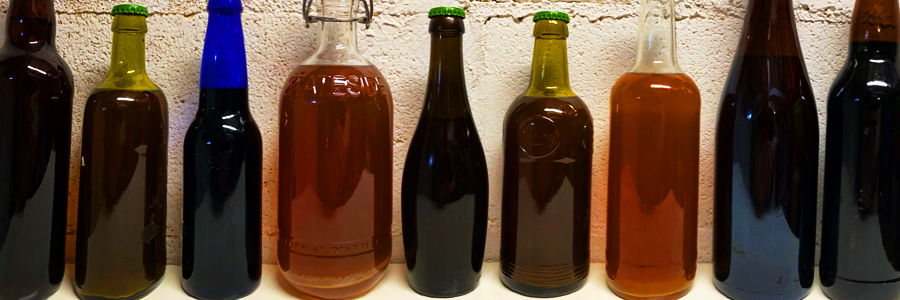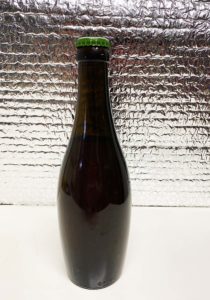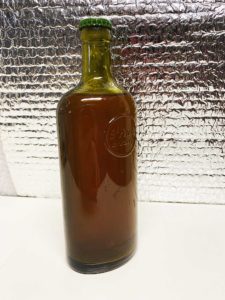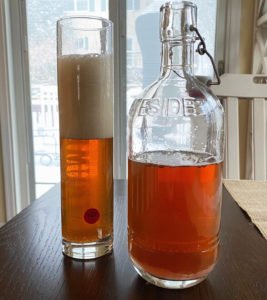Do you remember drinking craft and imported beer from bottles? Most of the craft beer drinkers I know are drinking from 16 oz cans, crowlers, growlers and occasional draft – but rarely from bottles these days. There is one segment of the craft beer drinkers that is still into bottles though – and that’s home brewers – particularly those over the age of 40.
Yeah, most of us still bottle and cap our home brew – and reuse the same bottles over and over. You know what happens? If you bottle long enough, reusing the same ones, you start to really get to know your bottles. For some of them you remember when you originally opened them and drank that beer. Others you look forward to reusing cause you think they are cool or interesting to look at. Still others are functionally better to use (hold more beer, or maybe have a swing top so you don’t have to cap them at all). And many have a story to tell,
I was going to write a really internal beer-geek home brewer piece about the bottles I have grown to know over the last 30 some years – but then I realized there is much more to it. So, let’s start with one of the best known bottles by craft and imported beer drinkers – the Orval “skittle bottle”.
Orval was – and for some still is – considered one of the best beers in the world. Coming from a Trappist monastery in Belgium – it is a very complex 6.2 abv ale, finished with wild yeast to give it some funk and a very dry finish. They have been brewing at the Abby since 1628 – though it was looted and burned several times by the French or Germans passing through Belgium through their various wars over the centuries.
In 1931 the present brewery was rebuilt and designed by Henry Vaes – who also designed the iconic Orval glass – and yes their bottle too. It is only sold in the shapely little 11.2 ounce bottles designed to look more or less like a bowling pin. The glass is thick to withstand bottle conditioning and shipping – and is an awesome bottle for home brewers to use for a “taster” when checking on the progress of your brew after bottling.
Another classic import, this time from Britain – Sam Smith’s Winter Welcome – and another great bottle. Each year since 1990 the brewery would create a special label commemorating the winter season, and fill their bottles with a golden caramel-like 6% ale.
The bottle shape is a throwback classic – with high shoulders and embossed name of the brewery carved right on it. It used to be sold in clear bottles, allowing all to see the golden splendor within. Unfortunately clear bottles don’t do well as light can “skunk” the beer pretty easily. So some years back (20?) they switched to dark brown bottles. But the early versions were clear – which is great for a home brewer who wants to see their beer settle and clarify. A classy and functional vessel for the brewer.
Now let’s go from the sublime of “Winter Welcome” to the ridiculousness of “Lagunitas Sucks”. Here we move to a real heavy weight of a bottle. Their 32 oz quart bottles were a great way to get attention to their “replacement holiday ale” – along with that name of course.
The story that the brewery circulated was that they ran out of capacity to make their slow fermenting “BrownSugga’ “ale for the holidays so they made their “Sucks” recipe instead. The name was an acknowledgement that they had screwed up. On their website they said: “It’s a mess that we can not brew our BrownShugga’ this year and we suck for not doing it. Whatever.” Not too many craft drinkers cared, as the 8% imperial IPA Sucks was enough of a present instead.
For a home brewer the quart sized bottles are a blessing – that’s almost three 12 oz bottles of capacity – and you only have to cap it once. Of course you have to drink it all when you open it, but so what? It’s only a quart. And the story of “Sucks” always brings a smile.
Back across the pond to England we find one my personal favorite bottles ever. The bottle’s design is copied from a 18th-century gin bottle that came from a shipwreck in the Delaware river near Gibbstown NJ. Ironically, this elegant bottle is used by St. Peter’s brewery which is located near Bungay Suffolk England and founded in 1996.
These guys make an absolutely killer porter as well as other well crafted traditional British styles. They use the oval shaped light copper colored gin bottle shape and also a similar circular one. Both are stubby 500 ml in size and are really cool to look at. They make any beer look cool – even if you brewed it by yourself. They foil wrap the top, but that obviously has to go when you clean them, but sometimes the classic oval label stays on, and that’s OK – especially if you are also lucky enough to be named Peter.
Staying in Britain for the moment, check out the sensuous curves of the bottle from Ridgeway Brewing in Oxfordshire. The really cool shaped bottle is used by this brewery known for it’s irreverently named Christmas beers like “Bad Elf” (and the stronger “Insanely Bad Elf”), “Reindeer Droppings” and “Santa’s Butt”.
One of their bottles I have still has the drawing of Santa (from behind naturally) looking over his shoulder sitting in his workshop – displaying his prodigious, but clothed rear. Most beer nerds are familiar with the term “butt” as a beer measurement, but allow me a moment to refresh your memory. The butt is an “imperial measurement” (British) which represented “half a tun” or “three barrels” of beer (about 130 US gallons).
So the story goes way back in the day (1700‘s) beer used to be served at pubs in England as a blend of three different ales – new low alcohol beer, regular beer and old stale beer. This way the pub could save money by not throwing out their old beer, and it didn’t taste that bad (for back then I suppose). This beer was called the “Three Threads” and the barkeep would have to pull beer from three separate barrels to pour a pint.
To make the whole process easier to deal with, brewers started making a blended beer in one large barrel and that beer was called “the entire butt”. Not sure how that relates to Ridgeway’s Christmas beer, the 6% amber ale, but as I recall it was a good beer, and they still make it. The bottle is unusual and interesting. Put a red bow around the neck and it’s a great gift for the holidays if you think your home brew is good enough to give away to friends.
There are so many bottles and stories, but I will close with a strange one from the Philly area. Unlike the other bottles discussed here, this one looks pretty much like a regular old macro-lager 12 ounce beer bottle. What makes it stand out is that it is made of dark blue glass.
These bottles came from an ill fated brewery called Independence that rose and fell in Philly in the early 90’s. They had purchased the “Nittany Ale” brand from a small brewery in York Pa (“White tale”) to capitalize on the Penn State sports popularity. They put the beer in Penn State Blue bottles emblazoned with the white Penn State paw print and distributed it in Philadelphia area.
The next part of the story isn’t clear, but I pieced it together from an old home brew blog post and a vague memory (hey, it was many beers ago!). The blog post was about the flood of blue bottles suddenly available at home brew shops. It said “I know in Pennsylvania blue bottle are on the cheap since Penn State issued Nittany Ale a cease and desist. My local shop was selling them for 5 bucks a case to get rid of them.”
This jives with my memory of getting blue bottles from my Home brew store in Havertown (“Brew Your Own Beer”) and thinking they were neat. At the time the only other blue bottles I had seen were the tiny “Sam Adams Triple Bock” bottles from 1994 and 95.
In any event, they were interesting and different, even though they are the symbol of a brewery that didn’t make it long. I broke a few and gave a bunch away, so only have a few left today, and they are always amusing to look at.
And it’s possible that bottles are actually going to make a craft-beer comeback – as the word from the Brewers Association is that aluminum cans are going out of stock across the country, and smaller and mid-sized packaging breweries may have to return to the old trusty bottle. Until the aluminum can supply chain can get back on line, glass may be the only alternative.
So, that’s my bottle story, thanks for listening, and as always keep appreciating great fresh craft beer – from a brewery, beer store or your own brew kettle!










